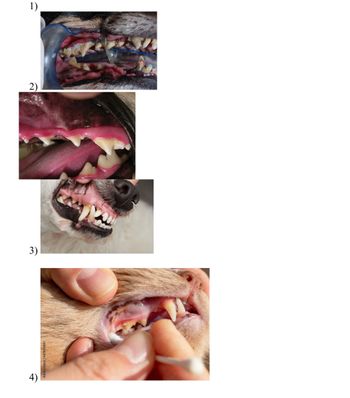Question

Transcribed Image Text:Write tartar and plaque level (0-4), and
periodontal disease (stage 1, stage 2, stage 3,
stage 4) in dogs or cats.

Transcribed Image Text:1)
2)
3)
4)
Expert Solution
This question has been solved!
Explore an expertly crafted, step-by-step solution for a thorough understanding of key concepts.
Step by stepSolved in 4 steps

Knowledge Booster
Similar questions
- Outline with a diagram and explanation, the life cycle and mode of transmission of Dracunculiasis (Guinea Worm Disease). Explain in such a way that a first year college student could understand.arrow_forwardCompare and contrast the chickenpox and shingles. For each disease, include in you answer: 1. Pathogen causing it 2. Signs and symptoms of each disease 3. What organs, tissues or cells are affected in each case?arrow_forwardState one significant identifying feature of the lesions of:(1) impetigo, and (2) herpes simplex.arrow_forward
- Describe and explain what is meant by the following (physiological disease, psychological disease and social disease). Outline some examples of each. Explain what is meant by communicable and non-communicable disease and provide examples of eacharrow_forwardWhat are the current diagnosis and treatments for adencarcinoma colon cancer. Give analysis and examples on we can detect the disease at the gene level. what treatment and therapies are available.arrow_forwardWrite about chorela. The Organism(Morphology, Staining, Metabolism, Genetics) The Disease(Pathogenesis and Epidemiology) The Clinical Picture(Diagnosis, Treatment, Vaccines) The Current Research(What the new studies regarding this disease? Must introduce a sample of the “newest” research in the subject) Global impact and future implications (What is the impact on this disease worldwide? What countries are affected? What is the economic impact? Are their ethical implications? Environmental implications?)arrow_forward
- respiratory syncytial virus * * What is the causative agent (bacteria, virus, fungus, etc.) of this disease? * Describe the causative agent. Where can it be found? How can it be transmitted? What are the risk factors attributed to getting this disease? This is where a graphic or video will help! * Discuss the signs and symptoms of the disease. * Discuss the diagnostic testing of the disease. * Discuss the possible treatments of the disease. * If there are statistics related to the disease, please include these as well. For example, how many people may have had this disease in the last year? In the last 100 years? Have there been any recent outbreaks?arrow_forwardDiscuss the formation of plaque on tooth surfaces.arrow_forwardExplain the dietary modifications for patients with Crohn's disease.arrow_forward
- Describe the range of pathologies associated with herpes simplexvirus infection.arrow_forwardExplain why croup is primarily a disease of children.arrow_forwardPick a relatively common disease in the United States and provide a brief description. Outline the causal and risk factors for the disease and whether the risk factor is modifiable or non-modifiable and what interventions might be implemented to reduce the number of people developing or progressing with the disease.arrow_forward
arrow_back_ios
SEE MORE QUESTIONS
arrow_forward_ios